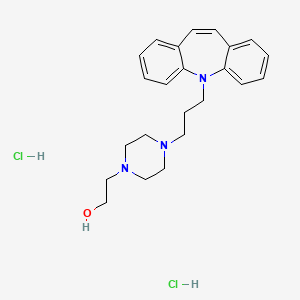



1. Hydrochloride, Opipramol
2. Insidon
3. Opipramol
4. Opipramol Hydrochloride
1. 909-39-7
2. Opipramol Hydrochloride
3. Insidon
4. Opipramol Hcl
5. Opipramol Hydrochloride [usan]
6. B49obi656m
7. G-33040
8. 1-piperazineethanol, 4-(3-(5h-dibenz(b,f)azepin-5-yl)propyl)-, Dihydrochloride
9. 2-[4-(3-benzo[b][1]benzazepin-11-ylpropyl)piperazin-1-yl]ethanol;dihydrochloride
10. 4-(3-(5h-dibenz(b,f)azepin-5-yl)propyl)-1-piperazineethanol Dihydrochloride
11. 4-[3-(5h-dibenz[b,f]azepin-5-yl)propyl]-1-piperazineethanol Dihydrochloride
12. Ncgc00093619-02
13. Ensidon
14. Pramolan
15. Dsstox_cid_25752
16. Dsstox_rid_81096
17. Dsstox_gsid_45752
18. Cas-909-39-7
19. Ncgc00162068-04
20. Einecs 213-000-2
21. Unii-b49obi656m
22. Insidon (tn)
23. 4-(3-(5h-dibenzo(b,f)azepina-5-il)propil)-1-(2-idrossietil)piperazina Dicloridrato [italian]
24. 5-(gamma-(beta-hydroxyethylpiperazino)propyl)-5h-dibenzo(b,f)azepine Dihydrochloride
25. Opipramoldihydrochloride
26. Schembl366168
27. Chembl1524185
28. Dtxsid5045752
29. Opipramol Hydrochloride (jan/usan)
30. Tox21_111210
31. Tox21_113153
32. Tox21_500128
33. Opipramol Hydrochloride [jan]
34. Opipramol Dihydrochloride [mi]
35. 4-(3-(5h-dibenz(b,f)azepin-5-yl)propyl)piperazine-1-ethanol Dihydrochloride
36. Tox21_111210_1
37. Ccg-220673
38. Ccg-221432
39. Lp00128
40. Opipramol Hydrochloride [mart.]
41. 4-(3-(5h-dibenzo(b,f)azepina-5-il)propil)-1-(2-idrossietil)piperazina Dicloridrato
42. Opipramol Hydrochloride [who-dd]
43. Ncgc00093619-01
44. Ncgc00162068-06
45. Ncgc00260813-01
46. D01477
47. Opipramol Dihydrochloride, >=98% (hplc), Solid
48. Sr-01000838066
49. Sr-01000838066-3
50. Q27274351
51. (z)-2-(4-(3-(5h-dibenzo[b,f]azepin-5-yl)propyl)piperazin-1-yl)ethanol Dihydrochloride
| Molecular Weight | 436.4 g/mol |
|---|---|
| Molecular Formula | C23H31Cl2N3O |
| Hydrogen Bond Donor Count | 3 |
| Hydrogen Bond Acceptor Count | 4 |
| Rotatable Bond Count | 6 |
| Exact Mass | 435.1844180 g/mol |
| Monoisotopic Mass | 435.1844180 g/mol |
| Topological Polar Surface Area | 30 Ų |
| Heavy Atom Count | 29 |
| Formal Charge | 0 |
| Complexity | 448 |
| Isotope Atom Count | 0 |
| Defined Atom Stereocenter Count | 0 |
| Undefined Atom Stereocenter Count | 0 |
| Defined Bond Stereocenter Count | 0 |
| Undefined Bond Stereocenter Count | 0 |
| Covalently Bonded Unit Count | 3 |
Adrenergic Uptake Inhibitors
Drugs that block the transport of adrenergic transmitters into axon terminals or into storage vesicles within terminals. The tricyclic antidepressants (ANTIDEPRESSIVE AGENTS, TRICYCLIC) and amphetamines are among the therapeutically important drugs that may act via inhibition of adrenergic transport. Many of these drugs also block transport of serotonin. (See all compounds classified as Adrenergic Uptake Inhibitors.)
Antidepressive Agents, Tricyclic
Substances that contain a fused three-ring moiety and are used in the treatment of depression. These drugs block the uptake of norepinephrine and serotonin into axon terminals and may block some subtypes of serotonin, adrenergic, and histamine receptors. However, the mechanism of their antidepressant effects is not clear because the therapeutic effects usually take weeks to develop and may reflect compensatory changes in the central nervous system. (See all compounds classified as Antidepressive Agents, Tricyclic.)